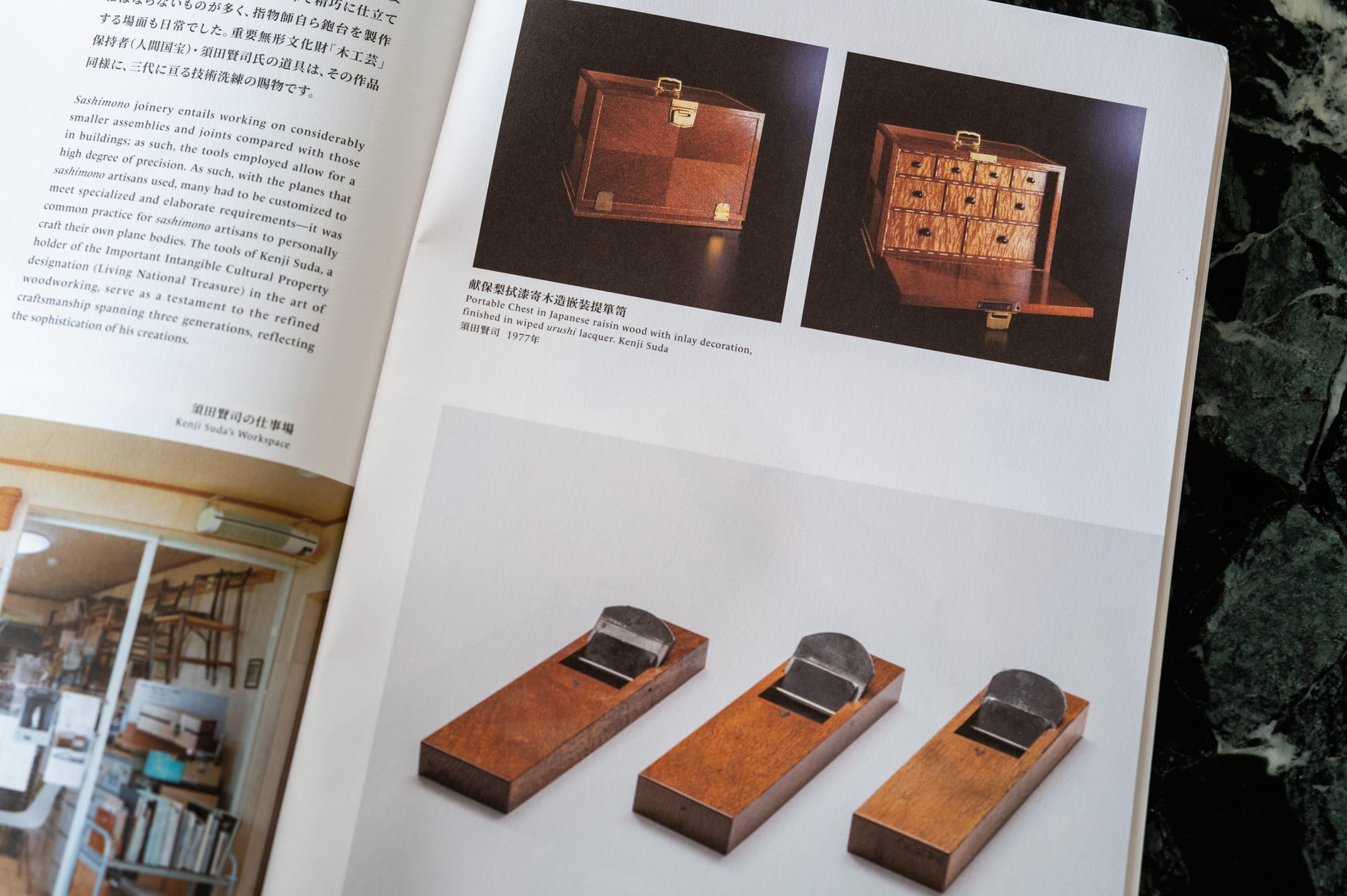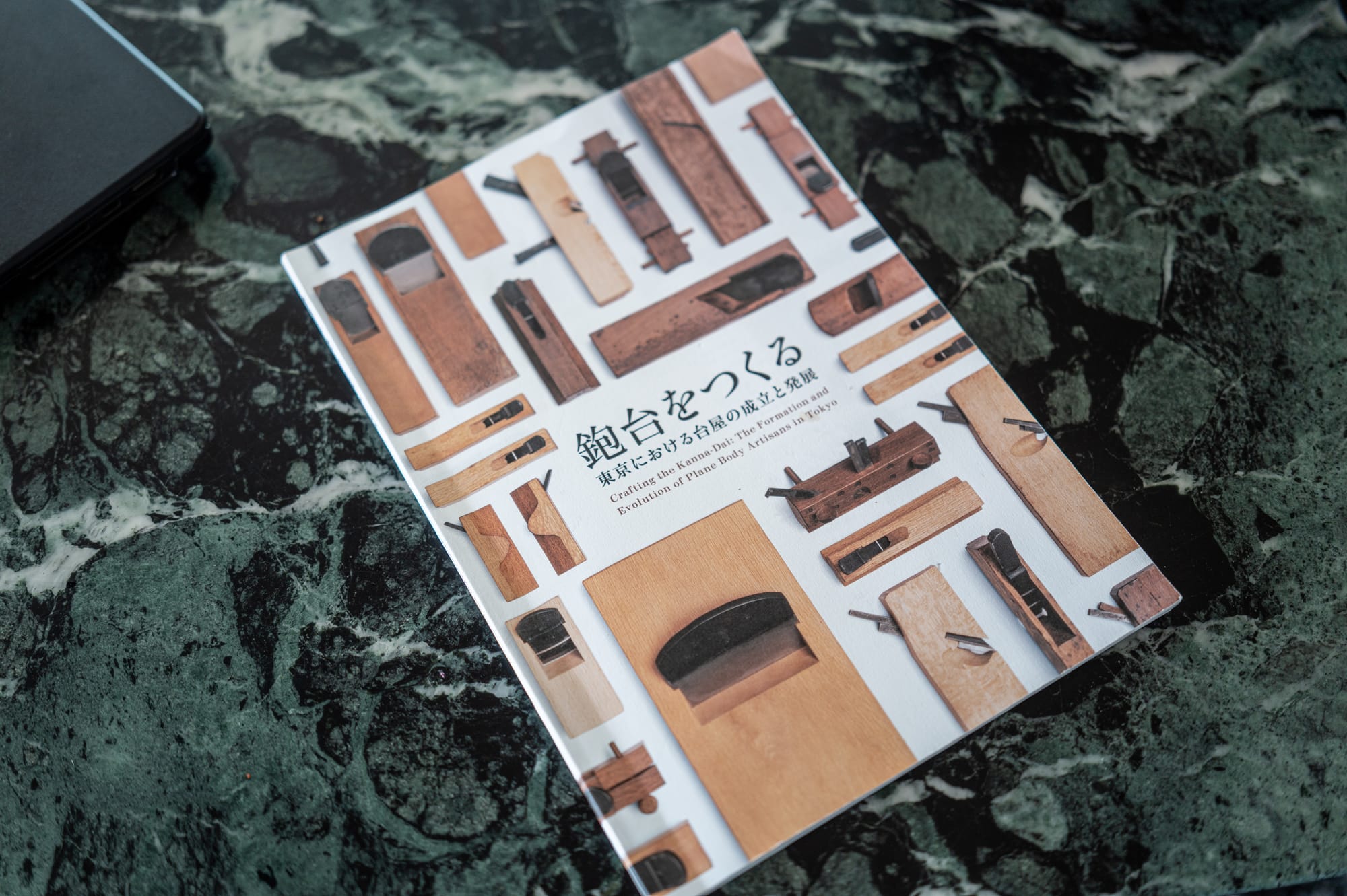Takanaka Carpentry Tools Museum graciously gave us permission to present a portion of their 2024 Kanna exhibition brochure, in english. This essay is by Suda Kenji, national living treasure sashimono. This excerpt was translated for Paklan by Togo Miyashita, apprentice of Tak Yoshino at Mount Fuji Wood Culture Society.
Miscellaneous Thoughts On Planes

木工に取り組んで今年でちょうど50年になろうとしている。岐阜で宮大工をしていた祖父が一念発起して1907年に上京し指物師前田桑明の門をたたいてから我が家の指物を中心とした木工藝の歴史が始まり、私が父の下で仕事に就いてからも半世起というわけである。しかしそれは人々が木を使ったモノづくりを始めてからの歴史に比べればほんのわずかな時間である。
It has been exactly 50 years this year since I started woodworking. My grandfather, who was a shrine carpenter in Gifu, moved to Tokyo in 1907 and opened the door for Soumei Maeda, a sashimono craftsman, and this was the beginning of our family's history of Mokkougei(fine wood art), mainly sashimono making. However, this is a very short time compared to history since people began to make things using wood.
木は焼き固めたり溶解したりという化学変化を必要とせず、すでにそこにある素材であり、ヒトが何か作ろうとしたとき真っ先に利用したはずである。木工が棒切れの利用から始まったにしても、今私がこうして木工藝家でいられるのは、その長い整史があったればこそであり、その末端に座している自覚は常にある。だからこそこの日本列島で取り組まれてきた木工の歴史を知りたいという思いは深い。「木工」という大きな世界の中において、私が取り組む現在の「木工藝」という機念は遡れば正倉院以降、人々が実用以上の美、「めでたきモノ」を求めた結果と言えるが、それには有史以前からの営々たる「木によるモノづくり」の助走期間がある。
The wood is a material that does not require chemical changes such as burning, hardening, or melting. Even though woodworking began with the use of sticks, it is because of this long history that I am able to be a kogei woodworker today, and I am always aware that I am living at the end of this history. That is why I have a deep desire to learn more about the history of woodworking in the Japanese islands. In the great world of woodworking, the current “Mokkougei” that I am working on can be traced back to the Shosoin period, when people sought beauty beyond practical use, or “something to be appreciated,” but this was preceded by a period of “making things from wood” that began in prehistoric times.
先日、長年の思いが叶って鳥取県の「青谷上寺地遺跡」を訪ねることができた。遺跡と言っても数次にわたる発掘調査はすでに終わり、遺跡の現場そのものはまた土の下である。
The other day, I was able to visit the “Aoya Kamijichi Ruins” in Tottori Prefecture, fulfilling a long-held wish. Although we call them ruins, several rounds of excavations have already been completed, and the ruins themselves are under the ground.

この青谷上地遺跡は主に弥生時代のおびただしい数の多種多様な木工品が出土したことで有名である。なかでも高杯やスリット状の透かしの入った蓋付きの器など繊細な細工を施した木工品が多く、約500年後の正倉院に続く木工史の空白を埋める貴重な存在だ。訪問は実物の熟覧が目的だったが、県立の大型展示施設の本年度開館を前に既存の小規模な展示館が閉鎖され、そこに展示されていたレプリカを拝見するにとどまった。とはいえ精巧なレプリカから多くを学び刺激を受けることができた。
This site is famous for the large number and variety of woodworks excavated, mainly from the Yayoi period. Among them are many delicately crafted woodworks, such as the tsukubai cups and slit watermarked lidded vessels, which are valuable in filling a gap in the history of woodworking that continued to the Shosoin repository that was built some 500 years later. The purpose of my visit to the site was to see the actual pieces, but since the existing small exhibition hall was closed before the opening this year of a large-scale prefectural exhibition facility, I could only see the replicas on display there. Nevertheless, I was able to learn a lot from the elaborate replicas and was inspired by them.
一見轆轤成形のような高杯は石川県の西念・南新保連跡など日本海側の遺跡から多く出土し、轆轤か刳物かの論争が続いている。西会・南新保遺跡の高杯は近年CTスキャンなどを通じて轆轤成形という一応の結論が出ているが、その大きさや飾り突起の存在などから反論も多い。青谷上寺地遺跡のものは刳物という説であったが実物で刃物痕や削り肌、逆目の有無など確かめられず残念であった。高杯は杯部と台部を円筒状のホゾでつないだものがあるが、このつなぎ方、ホゾの作り方はいかにも挽物の仕事にも思え異味は尽きない。
Many tsukubai cups that at first glance appear to be lathe-turned have been excavated from sites on the Sea of Japan coast, such as the Sainen and Minami-Shinpo Ruins in Ishikawa Prefecture, and there is ongoing debate over whether they are lathe-turned or gouged. Recently, through CT scans and other means, a tentative conclusion has been reached that the cups from the Sainen and Minami-Shinpo sites were lathed, but there are many arguments against it due to their size and the decorations. The cup from the Aoya Kamijichi site was thought to be gouged, but unfortunately we were unable to confirm the presence or absence of blade marks, shavings, or tear-outs on the actual piece. Some tsukubai cups have a cup and base connected by a cylindrical joint, and the way the cup and base are joined and the way the joint is made seems to be the work of woodturning, and is endlessly fascinating.
青谷上地遺跡の遺物では長辺40cm弱の長方形の箱に特に興味を惹かれた。長手の側板には妻板(短辺)の収まる小穴(板状の部材などが差し込まれる溝状のホゾ穴)が彫られ、長方形の箱の側板を構成する。四枚の側板下部には底板の入る小穴が彫られ、繊維方向を長手にとった底板が入り、それぞれ木釘で固定している。妻板は現代の箱の作り方と違い底板と同じ繊維方向に使っている。これは木の収縮をそろえた結果のようにも思え、その知識と工夫に驚かされた。側板に施されたへび状の線刻とともにまさに完成した指物作品と言える。
Among the artifacts from the Aoya Kamiji site, a rectangular box with a long side of less than 40 cm was of particular interest. The long side panel is carved with small holes (groove-shaped holes into which plate-like materials are inserted) for the short side to fit into, and it constitutes the side panel of the rectangular box. The bottom of each of the four side panels is carved with small grooves for the bottom board to fit into, and the bottom board with the fiber direction taken as the long side is inserted, each of which is fixed with wooden nails. Unlike modern box construction methods, the short side plates are made with the same fiber direction as the bottom plate. This seems to be the result of matching the shrinkage of the wood, and I was surprised at the knowledge and ingenuity of the craftsmen. Together with the snakelike line engravings on the side panels, this is a truly complete sashimono work.

